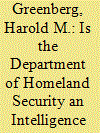| Srl | Item |
| 1 |
ID:
088578


|
|
|
|
|
| Publication |
2009.
|
| Summary/Abstract |
As part of the infrastructure for monitoring the movements of Private Security Companies (PSCs) in Iraq, a unique intelligence interface has been constructed to enhance cooperation between the military and PSCs. Using a wide range of existing intelligence-sharing agreements and guidelines for handling classified information, PSC contractors working with the US military have been able to provide unclassified intelligence products to the wider PSC community. Using lessons learned in Iraq as a contractor building this interface, the author explains how institutional difficulties were overcome and argues that the US military should be better prepared to share intelligence with the wide range of organizations it can expect to work with in future unconventional warfare or nation-building operations. Some of the lessons learned in Iraq can also be applied to the US Department of Homeland Security's Regional Fusion Centers, where many of the same difficulties with intelligence-sharing and integration with commercial organizations are being encountered.
|
|
|
|
|
|
|
|
|
|
|
|
|
|
|
|
| 2 |
ID:
088576


|
|
|
|
|
| Publication |
2009.
|
| Summary/Abstract |
The Department of Homeland Security (DHS) applies a variation of the intelligence cycle - the process of planning, collecting, processing, analysis, and dissemination of information characteristic of intelligence agencies - to mitigate the risk of terrorist attack and respond to national security breaches. The intelligence cycle helps DHS encourage voluntary security measures, serve its customers, and avoid economic disruption, but the Department's program setbacks and failures illustrate the difficulty of applying the intelligence model to the needs of homeland security. The Department's particular means of producing intelligence and information challenge the conventional conception and definitions of the intelligence cycle.
|
|
|
|
|
|
|
|
|
|
|
|
|
|
|
|
| 3 |
ID:
088577


|
|
|
|
|
| Publication |
2009.
|
| Summary/Abstract |
Scientific intelligence was coined during World War II, yet despite its age and relative importance it has not received the attention it should have. This is surprising given the recent and growing interest in WMD programmes. This article sets out the main components of scientific intelligence, seeking to explore how scientific intelligence has been defined, how it operates, and contemplates the key issues involved. In doing so it aims to set an agenda for future research into this crucial area.
|
|
|
|
|
|
|
|
|
|
|
|
|
|
|
|
| 4 |
ID:
088574


|
|
|
|
|
| Publication |
2009.
|
| Summary/Abstract |
In the winter 1978 issue of International Security, Raymond L. Garthoff authored a seminal article outlining common fallacies in United States government estimates of enemy intentions during the Cold War. Now, given the significant changes in threat over the past 30 years, it seems appropriate to take a fresh look at fallacies - evaluating old ones and introducing new ones - in enemy intentions estimates pertaining to post-Cold War (and post-9/11) security dangers. Based on its assessment, this article concludes that the challenges to accurate intelligence assessment of enemy intentions, and the need to move away from dysfunctional standard operating procedures, have never been higher.
|
|
|
|
|
|
|
|
|
|
|
|
|
|
|
|
| 5 |
ID:
088572


|
|
|
|
|
| Publication |
2009.
|
| Summary/Abstract |
Recently declassified materials have revealed the existence of a previously unknown network of Austrian communists in pre-war England. The group of young well-educated Viennese used unsuspecting social contacts and marriages of convenience to establish itself. Analysis of this network reveals some previously overlooked similarities between the 'Cambridge' spies Kim Philby and Alan Nunn May, as well as the emergence of a new nuclear spy, Engelbert Broda. Their wartime espionage as individuals took place at a time when non-communist British scientists were promoting the international sharing of atomic knowledge through unofficial channels. The newly released files reflect a characteristic preference of the British secret services for intelligence gathering rather than intervention and illustrate how vital leads follow from apparently trivial observations.
|
|
|
|
|
|
|
|
|
|
|
|
|
|
|
|